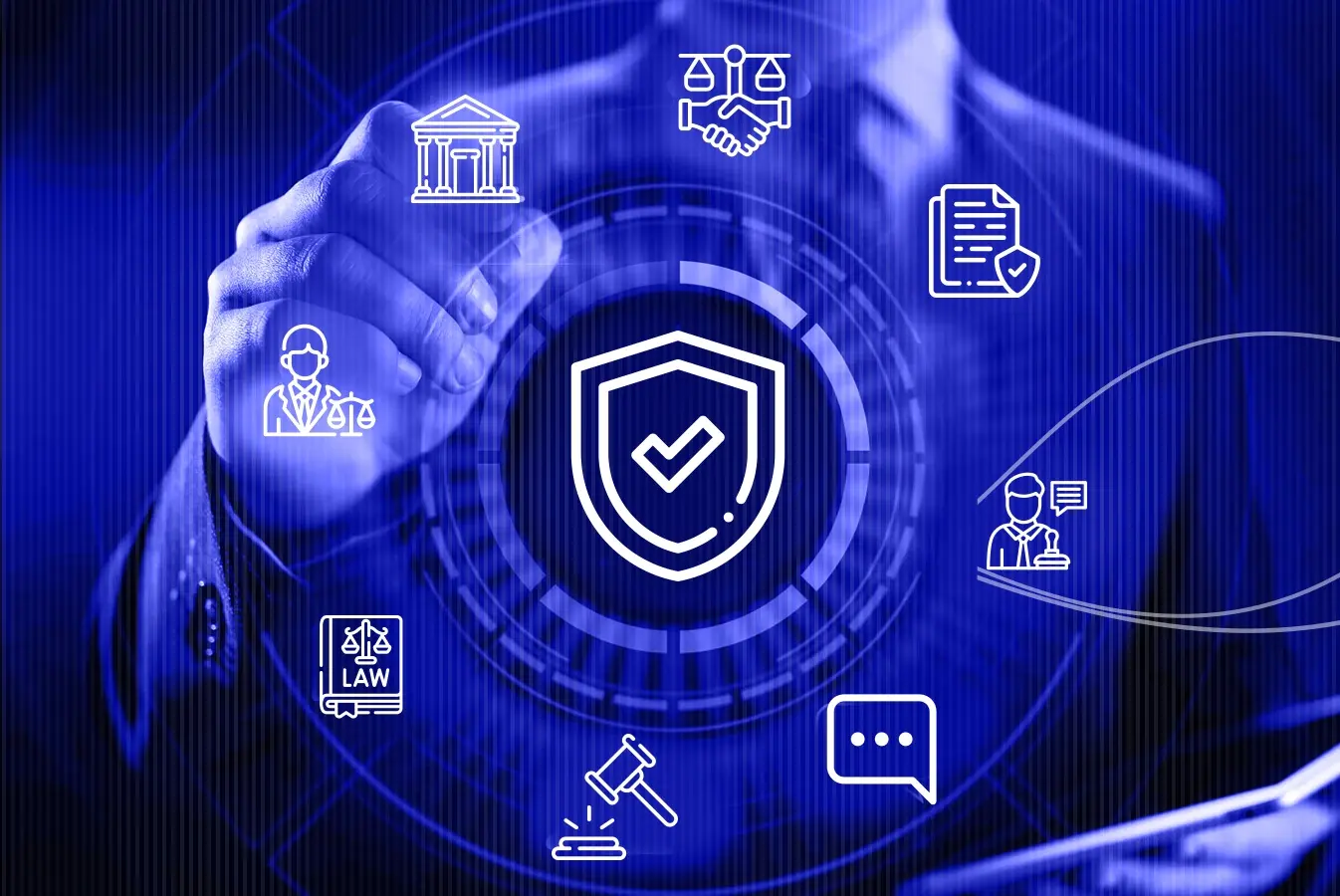8 Challenges in Handling Digital Evidence and How to Solve Them
by Daniyal Hassan, Last updated: August 19, 2025, Code:

Handling digital evidence is complex, with challenges in security, compliance, and storage. Discover how law enforcement can streamline digital evidence handling with secure, AI-powered management solutions.
Digital evidence handling is increasingly becoming a core part of all investigations, ever-increasing in size, and creates multiple problems with digital evidence when it comes to handling and managing them.
There are two ways in which digital evidence assists a case:
- Conventional crimes: It supplements other evidence, e.g., CCTV footage or phone data
- Cybercrimes: It is central, as the crime occurs digitally, e.g., malware or phishing attacks.
Interpol has assessed that cybercrime has been on a constant rise since the start of 2020, when the COVID-19 pandemic began. With the workforce moving online, the pandemic has led to the creation of many weak digital infrastructures that criminals are exploiting to access sensitive information.
The increasing amount of digital evidence creates more avenues for law enforcement officers to solve cases. Still, it can be made inadmissible in court if it is not handled properly, or its integrity is not being preserved at any level.
It means all efforts are in vain...
Handling digital evidence brings a tirade of problems for law enforcement agencies. Do you know how to protect the integrity of digital evidence in the most effective way? Is there any tool available to overcome problems faced by law enforcement officers in handling digital evidence?
In this article, we’ll explore the 8 major challenges in handling digital evidence and how to avoid them.
8 Major Problems in Handling Digital Evidence
Handling digital evidence is complex and requires strict adherence to security protocols, forensic procedures, and regulatory compliance. Law enforcement agencies and investigators face multiple challenges when collecting, storing, transferring, and presenting digital evidence. If not handled properly, digital evidence can become inadmissible in court, compromised, or even lost, severely impacting criminal investigations.
Below are the most pressing challenges faced in digital evidence handling and the best practices to overcome them:
1. Data Silos and Lack of Integration in Handling Digital Evidence
Perhaps, the biggest challenge in handling digital evidence is the presence of data silos, where evidence is stored across multiple disconnected systems, making it difficult to access, analyze, and share critical information.
Law enforcement agencies often use separate platforms for body cam footage, forensic reports, CCTV recordings, crime databases, and case files, leading to inefficiencies and delays in investigations. When evidence is fragmented across different storage locations, officers may struggle to retrieve relevant data quickly or ensure proper chain of custody.
To address this, agencies should implement a centralized digital evidence management system that:
- Integrates with existing law enforcement platforms (e.g., case management, RMS, and CAD systems).
- Provides a single, unified repository for all digital evidence types, ensuring easy access and retrieval.
- Eliminates manual evidence tracking by automating ingestion and categorization from multiple sources.
By breaking down data silos, agencies can improve collaboration, enhance case efficiency, and maintain compliance with legal and forensic requirements.
2. Risk of Tampering and Cyber Threats in Digital Evidence Management
Collecting digital evidence is easy in most cases. The tricky part is securing and protecting it from data breaches, tampering and cyber-attacks. It is very challenging to prevent these attacks and detect tampering as it is done discreetly to make it seem like it is still intact.
To avoid this problem, law enforcement agencies should opt for high-quality enterprise-level digital evidence management systems with robust security systems for evidence protection and tamper detection.
It should help maintain audit logs to track the lifecycle of evidence, ensure chain of custody, and preserve digital evidence in its original state.
When it comes to the storage of data, it's important to store them in encrypted formats and within hardware that has built-in security protocols.
A good option is to consider a digital evidence management system that can be deployed in the cloud using AWS or Azure, as both provide strong cloud security.
Additionally, for maximum protection against cyber-attacks, deploying a digital evidence management system on-premises is the best choice.
3. Complexity of Managing Diverse Digital Devices and Formats
Digital evidence now exists in multiple formats ingested from different devices, such as CCTV, body cams, drone cams, and home security cameras. For agencies, the problem is that the volume of digital evidence is increasing exponentially.
Digital devices do not have enough storage space to retain all kinds of digital evidence. Moreover, it is impossible to manually sift through all the evidence in different devices and file types to find useful insights.
To solve this problem swiftly, law enforcement agencies must have a complete digital evidence management system that can auto-ingest the evidence from various sources and support multiple formats to provide a centralized portal for storage, protection, and analysis.
A powerful system that uses artificial intelligence to search for spoken words, faces and objects within digital evidence instantly. In this way, it allows officers and detectives to speed up the entire process of investigation and to focus more on the actual analysis of relevant information.
This solution speeds up the investigation and allows officers and detectives to focus on the actual analysis of relevant information.
4. Inadequate Access Control Leading to Unauthorized Evidence Exposure
CJIS Security Policy clearly states that agencies need to store digital evidence in a controlled environment or secure physical location and restrict access to authorized individuals only.
This is a problem that agencies struggle with a lot while handling digital evidence, especially when they are enormous in number.
While storing the data in a virtual environment, agencies need to control access based on user roles so that evidence is available only to authorized personnel.
Also, keeping audit logs helps in tracking who viewed the evidence at what time. Choose a digital evidence management solution that allows such user and content segregation through secure and separate portals and case folders.
5. Human Errors and Mishaps Compromising Digital Evidence Integrity
No human is perfect, and errors are bound to happen due to causes like unintentional biases, excessive workload, technology usage errors, and random mishaps.
It is crucial to have trained personnel with appropriate knowledge and experience. The workload should be managed appropriately so that the investigation is not negatively affected. Any minor error could make evidence inadmissible in court.
Technology and automated systems should be utilized properly to help investigators manage the workload and focus on the right information.
To avoid mishaps, everyone except the chief investigator can be given view-only access so that the files are not mistakenly altered or deleted. Also, a digital evidence management solution should be chosen that allows the retrieval of the original file if some mishap has occurred in the shared version.
Also, it is extremely important to provide routine training of evidence handling, procedures to be followed and technology usage to the investigators.
6. Security Risks During Digital Evidence Transfer and Sharing
Evidence is most at-risk during transfer as data could be breached, exposed, or tampered with. Protecting digital evidence during transit is very difficult.
Storing on traditional devices like USB or laptops with just password-protection is not enough as these can easily be stolen and hacked. Simple online transfer through email is even riskier.
It is stated in the CJIS Security Policy that during the transmission of criminal justice information, the data should be encrypted to ensure protection. The encryption has to be FIPS 140-2 certified.
Hence, while adopting any digital evidence management solution, choose a solution that complies with these policies and follows all the required protocols to ensure secure transfer.
7. Challenges in Presenting Digital Evidence in Court
Finally, if the digital evidence is made inadmissible in court due to problems in handling it appropriately. Agencies should also be aware of how the evidence can be presented based on the court's technology setup and internet connectivity. Based on that, evidence should be transported and presented securely.
Download and present the evidence if it cannot be shown directly. If possible, capture and print image stills of video evidence and submit all other documents and images in print form to supplement the digital presentation.
Prosecutors must be aware of all the evidentiary requirements of admitting different types of digital evidence to ensure all the procedures are strictly followed.
Moreover, proper documentation of digital evidence’s chain of custody is required to prove in court that the evidence was retained in its original form and not altered in any way.
This chain of custody record should mention the time and place the evidence was collected from, ownership details of the evidence, where it was stored and details regarding who had access to it at what times.
Maintaining a chain of custody is difficult when it comes to digital files. Therefore, it is important to ensure that the digital evidence management solution you opt for provides a complete chain of custody report to record and show all these details.
8. Struggles with Compliance in Digital Evidence Handling
As laws around digital evidence handling evolve, agencies must continuously update their processes to comply with new regulations. For instance, data privacy laws such as GDPR and CCPA impact how digital evidence is stored and shared, especially in cases involving private individuals.
To ensure compliance:
- Agencies should implement policy-based evidence retention and deletion rules.
- Digital evidence management systems must offer automated compliance tracking and reporting.
A robust digital evidence management system is the optimal choice for ensuring compliance when handling digital evidence. These platforms come with built-in features that enable automated compliance, helping organizations—especially law enforcement agencies—adhere to regulatory frameworks.
For example, confidential details collected during investigations often need to be shared externally. To comply with privacy laws, personally identifiable information (PII) must be redacted before dissemination. A digital evidence management system equipped with automated red
action technology streamlines this process, ensuring sensitive information is obscured while maintaining compliance with legal requirements.
VIDIZMO DEMS: Complete Solution for Secure Digital Evidence Handling
Digital evidence is a core part of all investigations, so law enforcement agencies should adopt appropriate measures and solutions to combat the problems mentioned above.
As stated earlier, adopting a comprehensive Digital Evidence Management solution will lead to a smoother, speedier, and more accurate investigation.
To cater to all your problems mentioned above, VIDIZMO provides a robust platform, an IDC MarketScape recognized Digital Evidence Management System.
It allows you to ingest, store, handle, and share a massive amount of digital evidence, ensuring the highest levels of security and meeting compliance requirements such as CJIS.
With VIDIZMO DEMS, you can:
- Collect digital evidence from various sources such as body-worn cameras, drone cams, CCTV, dashcams, audio recordings, etc.
- Secure your digital evidence with AES-256 encryption at rest and in transit.
- Add another security layer to your digital evidence by integrating with SSO identity providers such as Azure AD, Okta, OneLogin, etc.
- Deploy on-premises data centers on the commercial/government cloud (Azure, AWS) or in a hybrid infrastructure.
- Assign specific role-based access to each portal user with predefined permissions to access and use the portal.
- Detect any tampering or alteration in your digital evidence through SHA cryptographic hash value.
- Maintain a comprehensive chain of custody reports of each digital evidence file, ensuring evidence integrity at all levels.
- Automatically detect, track, and redact faces, people, and other personal identifiers visible in digital evidence before sharing or presenting in the court.
- Highlight important information within the digital evidence by adding annotations and comments.
- Transcribe digital evidence in around 40 languages and translate them into 50+ languages using artificial intelligence.
- Share with external and internal portal users with a limited number of views, block download option, generate multiple links for each file, and much more.
Try VIDIZMO Digital Evidence Management System yourself for free - no credit card required!
Ensuring Secure and Efficient Digital Evidence Handling
The challenges of handling digital evidence are vast and complex, requiring a strategic approach to ensure its integrity, security, and legal admissibility. Law enforcement agencies must prioritize digital evidence handling best practices, including proper training, adherence to forensic procedures, and strict security protocols to mitigate risks such as tampering, cyber threats, and compliance violations.
By adopting comprehensive digital evidence management systems like VIDIZMO Digital Evidence Management System, agencies can centralize evidence storage, enforce chain of custody, automate compliance, and streamline investigative workflows. These advanced tools enhance collaboration, accelerate case resolution, and ensure adherence to legal and regulatory standards.
In an era of rapidly evolving digital threats and increasing volumes of electronic evidence, modernizing digital evidence handling is essential. With the right solutions, law enforcement can ensure secure, efficient, and legally compliant investigations, ultimately strengthening the pursuit of justice.
People Also Ask
Why is digital evidence important in investigations?
Digital evidence provides crucial insights and proof, either supplementing traditional evidence or serving as the central element in cybercrime cases.
What are the biggest challenges in handling digital evidence?
Common challenges include the volume and diversity of data, transfer security, access management, and maintaining a chain of custody.
How can law enforcement improve digital evidence handling?
Law enforcement can improve digital evidence handling by using secure evidence management solutions, enforcing access controls, automating compliance tracking, and utilizing AI-powered tools for quick search and analysis of digital files.
How can law enforcement agencies secure digital evidence?
By using encryption, deploying secure digital evidence management systems, and following compliance protocols like CJIS.
What is a chain of custody in digital evidence?
It is the documented process that tracks evidence handling, ensuring it remains unaltered and admissible in court.
What is the role of AI in managing digital evidence?
AI helps search for specific elements like faces, spoken words, or objects, and it assists in automating tasks like transcription and redaction.
Jump to
You May Also Like
These Related Stories

Cost-Effective Cloud-Based Evidence Management for Law Enforcement

Secure Evidence Management: Building Trust in Legal Systems



No Comments Yet
Let us know what you think